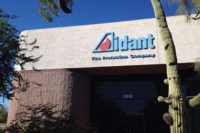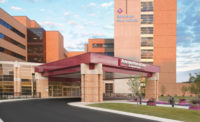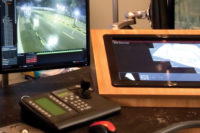
|
| The security booth at the Academy’s front entrance is equipped with a fire alarm systems map of the whole facility, along with a remote annunciator set up to provide real-time information on system status and events. |
An educational campus in Greenwich, Conn., recently invested more than $3 million in capital improvements to restore its 16 historic buildings and upgrade to the latest security and life safety systems. The 19-acre campus is home to the Westchester Fairfield Hebrew Academy, with 200 students attending kindergarten through the eighth grade, and the Greenwich Japanese School, which educates approximately 180 coeds in the same age range.
All of the Academy’s buildings had existing fire alarm systems, but parts for most of the systems were becoming obsolete — making it more difficult and costly to upkeep. Each one operated independently, making it nearly impossible to keep tabs on the campus’ numerous systems. The Academy determined a major upgrade was necessary in order to provide a high level of safety to its students.
“It was costing too much to maintain,” noted Ken Luhman, the Academy’s director of facilities. “We needed an alarm system that was flexible enough to handle all types of emergency situations, not just fire.”
Integrated Protection Services, a local provider of commercial and residential fire and security protection, had been installing security systems throughout the Academy’s campus since 2006. When the security dealer’s president, Art Greenwald, learned the school was planning a fire alarm upgrade, he saw an additional service that could be added for his customers.
“After researching the various fire alarm lines out there, we decided to become a Gamewell-FCI distributor in the spring of 2008,” Greenwald said. “We believed in the product line, but had to have confidence the organization would support us — and they did all the way.”
Protection Proposal
According to Luhman, high safety standards set by the school and backed by a recommendation from the town sent the Academy in search of a combination fire alarm/emergency communications system (FA/ECS).
“They were looking for a flexible, emergency communications system that would allow them, from any building, to initiate announcements and monitor what is going on, campus-wide,” Greenwald explained.
While the specifications of the system presented by Greenwald and local Gamewell-FCI sales manager, John Stofa, fit the bill, school officials were most impressed by its networking and adjustable messaging capabilities.

|
| A wide variety of buildings, many dating back before 1900, are scattered throughout the 19-acre Westchester Fairfield Hebrew Academy campus. |
“The E3 Series is truly a networked system that shows you what is happening on the entire system,” Greenwald described. “Clearly, the selling point was the ability from any panel to broadcast announcements to the campus or individual buildings or whatever else needed to be done from any panel in any building.”
The E3 Series Expandable Emergency Evacuation system, manufactured by Gamewell-FCI, utilizes a single pair of twisted copper wire or fiber optic cable to integrate all system nodes, including the fire alarm control panels. Less wire meant lower material and labor costs as well as reduced harm to the historic buildings’ facades.
“Having the redundancy built-in where any panel could be a command post was a key point for the school,” Stofa said. “If you make one location your only command post, and it isn’t tenable, then you are vulnerable.”
The system offered by Integrated Protection Services is referred to as a more “survivable” system, with its intelligence or data housed in nodes through the network. If one or more panels or nodes are damaged, a distributed system such as this ensures the remaining components continue to operate properly.
With half of the campus serving the needs of the Japanese school, the ease of creating prerecorded emergency messages in any language was a valuable element of the Academy’s new system. “A wave file can be recorded and loaded into the system right on site,” Stofa explained. “And having a series of messages that clearly articulate information or instructions in one or more languages at your fingertips during an emergency can have a huge effect on the outcome of occupants’ actions.”
Another key element of Greenwald’s proposed system was a portable graphic annunciator designed for security and facilities personnel and first responders to monitor the campus’ entire FA/ECS in real-time. The FocalPoint Mobile unit would provide floor-by-floor layouts of every building on campus, complete with all system components and an in-depth log of every event.
A tight timeline was set for the installation of seven E3 Series fire alarm control panels throughout the campus. For approximately nine weeks over the summer, the system was put into place and commissioned right before the start of the following school year in the fall.
Approximately 650 devices are connected to the system campus-wide, including 150 notification appliances and 500 smoke detectors, heat detectors, duct smoke detectors, beam smoke detectors and a number of magnetic door holders. The same system also monitors water flow in the sprinkler system and tamper switches on the sprinkler system valves.

|
| A facility manager tests the Academy’s live paging functionality using one of the network’s local operator consoles. |
An inherent feature of the E3 Series system is its ability to utilize many common types of existing fire alarm wire, saving a substantial sum of time and expense for retrofit jobs. “We are using less copper, conduit, labor and material to do an installation. And given the system’s 625k baud LAN (local area network), it operates twice as fast as most of the competitive offerings available today,” Stofa said.
In addition to repurposing a large amount of wiring used by the old systems, Integrated Protection Services ran dedicated fiber optic cable between the buildings for networking purposes. Fiber is almost impervious to severe weather conditions and surges from lightning strikes, making it a great conductor for exterior applications.
“This system gave us the capability to connect using a new fiber-structured Ethernet, which eliminated some of our old inter-building connection problems,” Luhman exclaimed. “I think this is the key if you have that technology in place already, which most schools do.”
According to Stofa, fire alarm and emergency communications systems similar to the Academy’s are being installed in schools as well as hospitals, industrial facilities and various commercial buildings nationwide. “No one wants to go through a tragedy like Virginia Tech witnessed, but if they have to deal with a fire alarm, terrorism or weather-related emergency, or need just general paging, this type of combo system is an excellent solution,” Stofa said. “Rather than functioning solely as a fire alarm system, it can also be employed as a supervised means of emergency notification.”
With a code-mandated fire alarm as the backbone of this emergency communications system, no room exists for fault tolerance. Issues aside from emergencies, such as line breaks, panel tampering and even dirty detectors, are identified by the system and reported to the central monitoring station immediately.
Requirements stated in the latest version of NFPA 72®: National Fire Alarm and Signaling Code, also mandate supervised systems to have 24 hours of battery back-up and undergo regular testing.

|
| The E3 Series panel is located in main entrance of the Jewish School classroom building. |
“When we did our regular fire alarm tests and other drills, the system performed fine,” Luhman said. “We also have the capability to do individual building drills, which is a nice feature.”
A FA/ECS should be flexible enough to provide a custom fit for each application while able to be modified easily for future expansion or reconfiguration. Officials at the Westchester Fairfield Hebrew Academy wanted the ability to send emergency communications to specific buildings and campus-wide. What they received was a scalable system capable of delivering live paging and pre-recorded messages to any pre-defined area of the campus, big or small. — Contributed by Gamewell-FCI






